Builders' Forum |
|
| ↓ Scroll to Last Comment ↓ | Forum Guidelines | Builders' Forum | |
Shearwater 17 as tripping boat? Cargo volume question
Hi all, new member here. I've built a cedarstrip Redbird canoe in the past, and am hoping to build a hybrid Shearwater 17 someday fairly soon.
My wife has a kevlar Current Designs Solstice GTS high volume that we really like. It seems to have similar paddling characteristics to the Shearwater, and is able to swallow enough gear for a week of paddling. It has 385L of volume, which I presume is volume in the hatches.
Does anyone know how the Shearwater's cargo space compares?
Here's the site with specs for the GTS HV.
https://www.cdkayak.com/Retired/Solstice%20GTS%20(old%20style).pdf
I have a feeling the Shearwater cargo volume is considerably smaller. Is there a way to modify the build for more cargo volume? I know on my stripper canoe you could add a strip of height.
Thanks.
23 replies:
RE: Shearwater 17 as tripping boat? Cargo volume question
The other option is the Merganser that Eric designed. It is very similar to the Shearwater. It has several configurations. One may suit yours needs. Eric is very approachable if you have questions.
http://shearwater-boats.com/product/merganser/
Dan
RE: Shearwater 17 as tripping boat? Cargo volume question
Adding a strip to increase volume for increased loads would permit a raise in center of gravity when loaded to the maximum. Be prepared for a little more instability under those conditions, unless the increased weight results in greater displacement, i.e. does the as-designed hull's waterline 'footprint' increase when fully loaded? What would be called reserve stability?
RE: Shearwater 17 as tripping boat? Cargo volume question
Thanks so much, everyone. I will see if CLC themselves can answer my question. It sounds like adding a strip would be ideal, but I'm not sure how it would work with the deck forms.
I may also look into bigger hatches, and check out the Merganser design too.
RE: Shearwater 17 as tripping boat? Cargo volume question
It looks like the Merganser is just available as plans, but I'm hoping to get a full kit.
I wrote CLC about adding a strip to the deck. Will see what they say.
RE: Shearwater 17 as tripping boat? Cargo volume question
Terry from CLC got back to me with a thorough answer.
We estimate that the cargo capacity of the hatches in the Shearwater 17 Hybrid is approximately 350L (12-1/3 USG) with acceptable performance..
I asked how they would suggest modifying if I wanted more volume.
It would be very easy to modify the Shearwater for a higher deck, especially a hybrid deck. If you are building from plans, you could just add an inch to the top of the sheer panel (and thus an inch to the sheer), and/or increase the deck camber to make a higher arch. Either method will produce a taller kayak with more internal volume, but loading it that high might reduce stability if not packed with care.
The least expensive way to get more volume would be to build the hybrid boat, leaving the hull sides intact but increasing the camber of the temporary deck forms. They are made from a tough particle board, so it would be pretty easy to cut pieces of board with a greater camber and glue them to the tops of the forms that come with the kit. You could do that before putting the temporary forms in the hull, and then line up the forms to see if you have achieved the overall camber you desire. Then the strips will follow the new frames and you build the deck.
Although we cut the Shearwater kits, the boat is not our design. If you wanted to get amended plans or cut files, you would need to talk to designer Nick Shade. Nick is very approachable, and might have other ideas about this project, so send him an email: https://guillemot-kayaks.com/ (the "Contact Us" email link is under "About Us" on the website.
RE: Shearwater 17 as tripping boat? Cargo volume question
I contacted Nick Shade to see if he is able to provide digital cut files for temporary deck forms for a higher deck on the Shearwater, and if so whether CLC can cut the new deck forms for me.
If not I will DIY modified forms.
RE: Shearwater 17 as tripping boat? Cargo volume question
At the risk of being called a "nitpicker" I believe 350 liters comes to about 94.46 U.S. gallons. I'm thinking that "12-1/3" above is meant to be cubic feet?
.....Michael
RE: Shearwater 17 as tripping boat? Cargo volume question
Gramps has got it right.
a quick back-of-the-envelope calculation of the shearwater 17 is
17 ft long X 2 feet wide X 2/3 (8 inches) foot tall trapezoid so multiply the results by 1/2 or ~11.2 cubic feet. which is pretty close to 12 1/3 cubic feet.
remember this is not cargo volume....but the total enclosed volume. (so they assume the cockpit is closed off.
the boat should float on her lines which you might think of as ~ 3 inches deep or .25 ft x 2 ft x 17 * .5 or about 4.2 cubic feet at 62 lbs per cubic foot is 260 lbs which is pretty close to the max payload of the shearwater at 270 lbs.
if you loaded her up to sink her another inch....you would be carrying about another 90 lbs.....
as pointed out....you do want to keep the weight low and at some point, the boat really will not perform well if you are too far out of the designers assumptions....
anyway.....i am also surprised...that they referred you to nick...i thought it was eric's design (they are brothers).
h
RE: Shearwater 17 as tripping boat? Cargo volume question
First thing is to make "cargo" no bigger than what a back packer would carry. Then remember that you can pack it into many smaller drybags that fit into smaller spaces.
Adding height to the hull or crown to the deck might give you more space inside but it also gives other problems like center of balance, increased windage, etc. Before you change the design perhaps look into how often you will require a touring boat.
RE: Shearwater 17 as tripping boat? Cargo volume question
Thanks Grumpy. I've been sea kayaking for over 30 years, from Baja to Haida Gwaill to Greenland to Baffin Island to Lake Superior to Georgian Bay, on trips up to 3 weeks long, so I'm familiar with how to pack a sea kayak.
There are plenty of low density items to pack above waterline on a trip. We always keep the heavy stuff low and close behind the seat.
On the original posting I am comparing with my wife's Current Designs GTX HV, which we are *very* familiar with and like. It is similar to the GTX but has a slightly higher deck, just as I'm thinking for the Shearwater.
RE: Shearwater 17 as tripping boat? Cargo volume question
i thought i would add, what i hope would be, a useful comment on adding more volume to the shearwater 17 by raising the shear line by ~ 1 inch.
based on above, we all acknowledge the concerns about loading and center of gravity and i think, absent manifestly overloading the boat, this can be easily managed. so i thought i would share a paddler's perspective as somebody who has paddled the shearwater extensively as well as a lot of other kayaks.
so first, the shearwater 17 is a sports car-like kayak. very low to the water. tight, cockpit and very little windage. it is a pretty amazing hull and one of the few stitch and glue boats that i really enjoyed as an advanced paddler.
it handles exceptionally well in all kinds of sea states and very easy to make way in a blow compared to most other boats. so i would not be concerned about weight or windage by raising it an inch. even an inch taller, it will still be svelte and slippery compared to most boats on the water. in my view, it will just be more roomy, more volume for camping or whatever. you will also pick up some knee bend room and feet space. so for me, its more about, will you like how it looks if you bring it up an inch?. my sense, is most people won't even notice unless they know what they are looking for.
below is a picture of my shearwater with 170 lb paddler and a couple water bottles under the deck. (not a hybrid...but the underlying hull and shearline is the same). you can see what i mean by this design is on the low volume side. i would also highlight that based on the design spec on this boat, ~80 lbs of addition well placed cargo can be managed...if you could find a way to physically get it into the storage areas which are pretty tight. (which is why i assume you would want a high deck version).
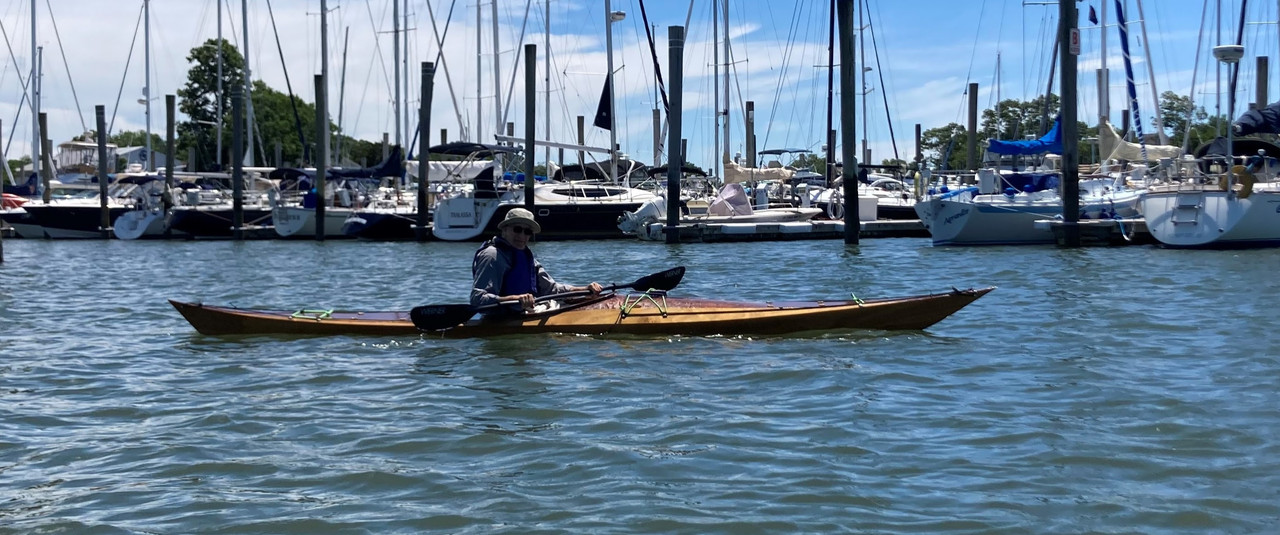
here is another view out of the water:
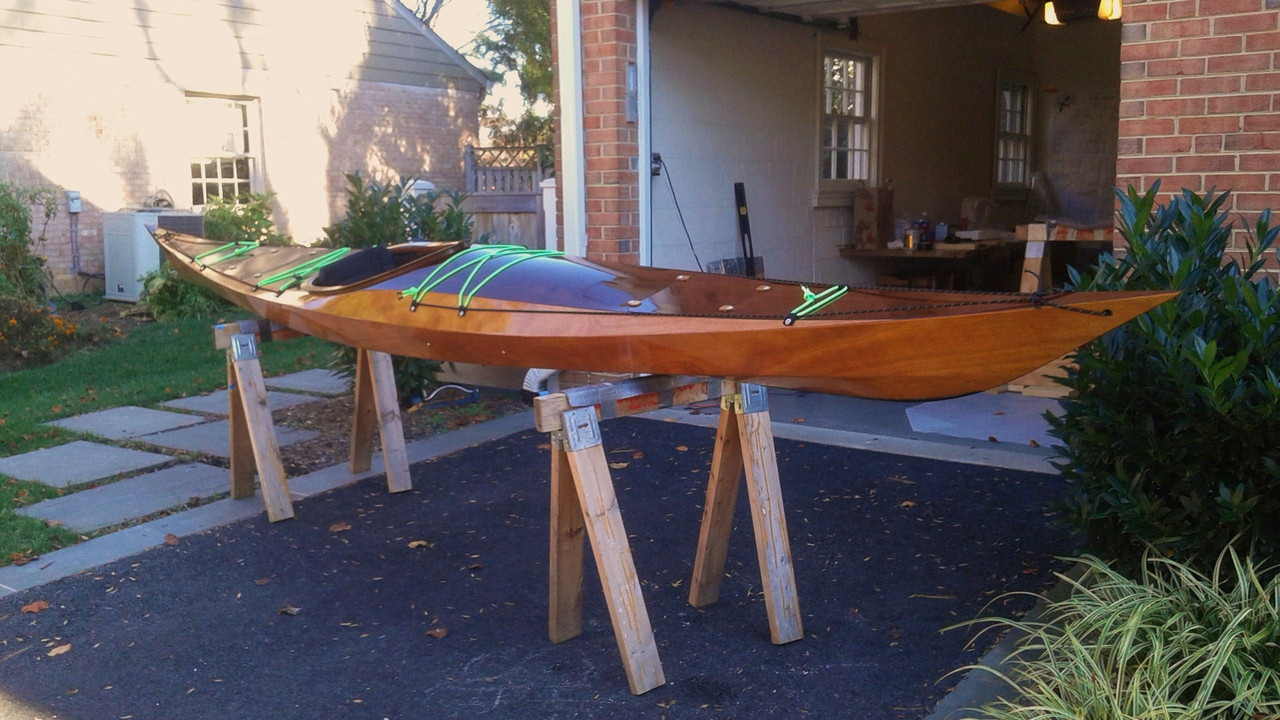
i would add to my thoughts that i also, have a pair of night herons - the regular and the high deck (about a 1 inch height difference) and they both paddle remarkably well and look very svelte.
most people, unless they see them side-by-side, can't tell the difference. as a paddler, the high deck is noticably more roomy and more foot room and knee bend....so i think you will find something similar in your proposal re the shearwater.
my sense, fwiw, is that for the shearwater, Eric just never decided to draw a high deck or 'normal volume' version....my guess is that what you propose will not be a problem.
h
RE: Shearwater 17 as tripping boat? Cargo volume question
not sure why that happens...but see my new post above
RE: Shearwater 17 as tripping boat? Cargo volume question
Hspira, thanks for your valuble input.
Coming from someone like you with experience in the Shearwater and NH high deck, I'm confident the boat will be fine if I can build it. It will need to be a hybrid to add the height.
PS - your Shearwater is gorgeous! The deck is a thing of beauty.
RE: Shearwater 17 as tripping boat? Cargo volume question
Just to give a couple more pics of how subtle the difference is between a high deck and a regular version..... in the night heron's i spoke about.
below is my night heron high deck (this is 100% strip):
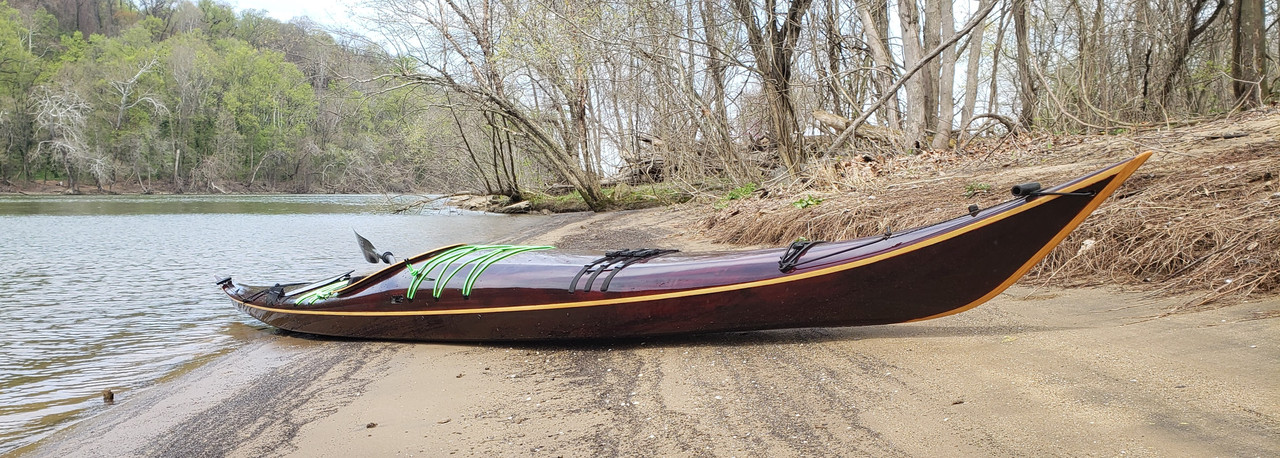
and this one (with the green hull) is the night heron regular hybrid:
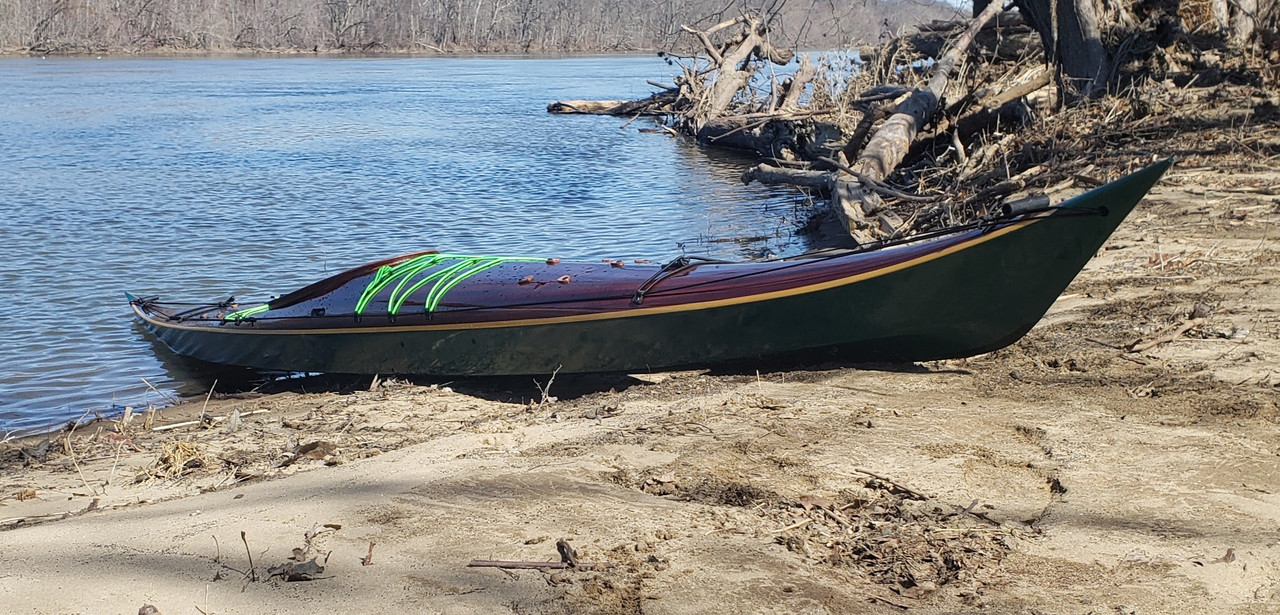
anyway, the high deck is more roomy and gets more use as i get older and less flexible. but most people would identify the green hulled boat as having more volume.
so the other thing i would say is color and things like striping and positioning of the rigging also impact the perception of sveltness. its the same effect tailoring and patterns can have on clothes....a larger volume pant can appear more svelte than a lower volumne pant based on variations in cut color and stripes.
the only other point i would make on the high volume editions (to consider as you think about this) is the most simplistic way is to add one inch along the entire shear.....but when designers create a high volume boat they more typically subtly alter the camber of the deck with most of the height added in the middle and the ends often stay the same....if you study the plans for the night heron version...you will see what i mean.
h
RE: Shearwater 17 as tripping boat? Cargo volume question
Wow, you build spectacular boats! Those are both works of art.
My plan is to get a Shearwater hybrid kit but modify the forms for the strip deck exactly as you said, with a gradual higher camber to allow 1 more strip on either side total, rather than just add a strip to the shear line.
As an aside, how did you learn boat building? You are clearly quite a craffsman. I took a course in the 90s with Ted Moores, but nothing since.
RE: Shearwater 17 as tripping boat? Cargo volume question
Hi Richard,
thanks for the note and the question. i started building almost 25 years ago with a chesapeake 17 LT kit in my garage and no formal experience. i had the manual and the forum had just started up. as a kid, i built model planes and was handy with basic tools. but i did not own a block plane until i started my first boat. so to answer your question more directly, i would say i was home schooled and did the folllwing:
- i took it as a hobby to be enjoyed....worked slow, read everything i could get my hands on and learned from everybody
- i started with kits, read the instructions carefully and used the forum a lot
- i made a lot of mistakes, held myself accountable....but did not punish myself...just used mistakes as learning experience... and worked over time to improve my skills
- i alway considered boats a form of applied art....and i focused on projects that i thought created things that were beautiful. below is my favorite..paddles like a dream :)


RE: Shearwater 17 as tripping boat? Cargo volume question
Thanks for that. You sir are indeed an artist. I hope to build the boat when I cut back my work week in a year or two so I too have time to go slow and play with it.
RE: Shearwater 17 as tripping boat? Cargo volume question
Maybe on a slightly different tack- can weight be safely saved for a tripping boat by using a lighter glass weave on the interior layers?
Are there areas where only an external glass layer is needed other than the bow and stern compartments on a hybrid build?
I know you can bulld an ultralight boat for playing around, but not sure about tripping with full load of gear.
Thanks.
RE: Shearwater 17 as tripping boat? Cargo volume question
Hi Richard,
on your question on a lighter build by using a lighter weave. the short answer is yes.
that said, i have done a lot of work and have sort of a fixation on building light. so the petrel above, for example, is only 29 lbs. the night heron high deck strip-built is close to 38 lbs. and i have a petrel play strip built-that came in at 27 lbs.
one of the things i do is create a spreadsheet (sample below) with all the components and their weights. so bascially before i build a boat these days, i actually project the weight i am shooting for. anyway, it helps you understand where the opportunities are. in summary, the big opportunities for weight saving is more associated with careful epoxy work....and not the weight of the weave though clearly a heavier weight weave needs more epoxy to we it out and fill the weave.
anyway, i would probably not mess with changing weights of glass on my first boat.....but you can....through the forum and some practice, do a lot with respect to being careful with your use of epoxy.
a tripping boat should be built strong....which is why i would not start (without some accumulated experience)....reducing recommended cloth weights. but you can get good results with careful epoxy work makes the boat light. it's with epoxy work that most first-time builders make their boats unnecessarily heavy.
h
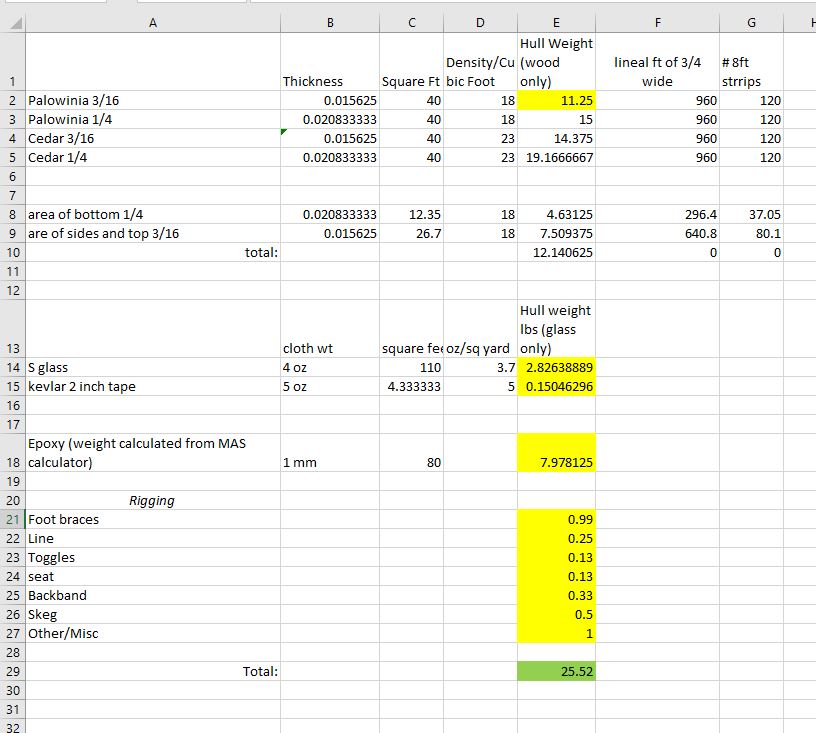
RE: Shearwater 17 as tripping boat? Cargo volume question
Thanks. This isn't my first boat, but my first in quite a while. For a tripping boat I wouldn't mess with the glass thickness on the outer hull. The places I was thinking of weight saving were the inner glass under the deck, and maybe the cockpit. I'm not sure those are as essential for strength.
I agree clean epoxy work can make a huge difference.
Great job on the Night Heron- I wonder if thinner or lighter strips on hybrid deck would be any weaker, given the same outer skin?
RE: Shearwater 17 as tripping boat? Cargo volume question
Hi Richard,
in general thinner skins and cores are weaker.
at the same time, when i look to lighten a boat, i routinely play with the core thicknes (1/4 inch vs 3/16) and material (eg paulownia and western red cedar) and the skins on the inside outside - 2 oz, 4 oz 6 oz and skin composite material - e-glass vs s-glass.
i would also note its important to think about the 'strength' more broadly as the strength of the total composite and the expected forces you want it to resist.
In a kayak, the three things that jump to mind are scraping/abrading type of forces and then there is compression and tension and finally bending or torsional type of forces. So I would be careful, for example, to think inner skins are less important than outer skins….in many cases it’s the inner skin on a kayak that is taking the load (on a composite) because that’s the side that’s in tension. (e.g., when you push inward on a kayak hull, the inner skin is taking most of the load vs the outer skin is in compression).
Ok….so all that babble aside, hulls are typically doing more work than the deck…so I often build decks lighter….but I return to normal or beefed up spec in the cockpit area and around hatches because that is where loads build up. So on a ‘light build’ boat I spend the extra time to do a more tailored layup to put the glass and epoxy and core thickness where it is needed and less where it is not needed. To deal with areas that are likely to be abraded, I put rub pads in those areas but otherwise don’t bulk up the hull or use a thicker layup.
Some other tricks include completely filling the weave on the outside, but on the inside I just ensure everything is wet out and only completely fill the weave on the cockpit floor. I also use a lot of s-glass (its expensive – but it’s a small quantity) because S-glass is ~ 50% ‘stronger’ than e glass so you can go with a lighter layup for the same strength. Interestingly. For stiffness, a thicker core with lighter skins is typically less weight than a thinner core with heavier skins for a given ‘stiffness’ (the resistance of bending/torsional forces). But of course, this only holds true for ‘light-weight’ cores like cedar and paulownia…but does not hold up for a okoume hull.
Advanced manufacturers, fwiw, use a computer program called finite element analysis to stress the structure in simulated environments to tell them exactly what strength (and layup) they need at any point of the hull.
So in summary, based on your note, I think you can go lighter, thinner on decks….but around any opening like the cockpit or hatches, return to normal or built up schedule. However, I would also note that if you expect to do paddle rescues or any of the other classic kayak rescues where you pull a boat up over your deck or climb/crawl up on your deck…the inside skin of the deck in those areas takes a lot of load as you are pushing into the hull hard and needs to stay beefy.
I hope this was helpful…if not a bit confusing.
h













RE: Shearwater 17 as tripping boat? Cargo volume question
» Submitted by hspira - Wed, 9/14/22 » 10:14 PM
Hi Richard,
i have paddled the shearwater 17 and several of the Solstice series. yes....the GTS HV is bigger than the shearwater....but they are both relatively sporty boats and significantly smaller than the GT which is like a large sport-utility vehicle.
adding volume by simply adding an ~ inch increase to the shear line is a pretty common approach to increasing volume (that basically is the only difference between the chesapeake regular and corresponding LT series).
so something like 'adding a strip' to the top of the hull of the shearwater 17 could easily be done with the hybrid.
fwiw, whenever i look to modify a design like that i try to check-in with the designer or CLC....Eric Schade is still alive....so you might try to contact him if CLC is mum on the topic. but based on my paddling experience, i don't think it would be a big deal. CLC or Eric are also likely to have volume numbers that can help in your comparison.
the other thing you would want to consider is a hatch design that is potentially larger than the plan to be able to get stuff in/out easier. shearwater hatches are relatively small compared to how a solstice is configured.
anyway, the shearwater 17 hybrid is a beautiful boat and paddles really nice.
best, of course, is to test paddle one and to come out with a tape measure to check out your ideas. there is a thing called the builders club https://www.clcboats.com/builders_club/search/ where you might be able to find a shearwater 17 close by to see if having one in front of you in person seems to support your idea or not.
h